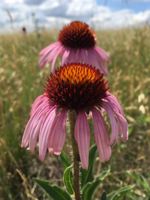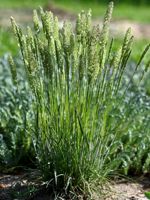Mon-Fri 9am - 5pm Mountain time
Narrow-Leaved Coneflower (Echinacea) vs Junegrass
Echinacea angustifolia
Koeleria macrantha
NOT AVAILABLE THIS SEASON - MIGHT RETURN
NOT AVAILABLE THIS SEASON - MIGHT RETURN
Narrow-Leaved Coneflower is a native perennial wildflower known for its pink to pale purple, daisy-like blooms. The petals (rays) droop downwards, around a dark, domed center, giving the flower a cone-like appearance. The nectar-rich blossoms attract a wide variety of pollinators, including native bees and butterflies. After flowering, the seeds provide food for birds, further adding to its ecological value.
Once established, it is drought-tolerant due to its deep taproot, which also helps stabilize soil. Narrow-Leaved Coneflower thrives in a variety of well-drained soils, including sandy, rocky, and alkaline. It often grows alongside the native grasses that characterize prairie and grassland ecosystems, making it well-suited for prairie and grassland restoration, naturalization, and pollinator gardens.
Junegrass is a native, low-growing perennial bunchgrass commonly found in prairies and open woodlands. It is a great choice for prairie restoration and naturalization projects or an attractive accent in ornamental plantings. Spear-shaped seed heads rise above the gray-green lower leaves, maturing to a tan color. Flowering earlier than other upright prairie grasses, it greens up quickly in spring and maintains its appeal well into the fall. It is shorter in stature and rarely forms thick stands, which adds to its understated visual appeal.
Adapted to cooler climates, Junegrass thrives in well-drained, rocky, sandy, or gritty soils and can tolerate drought, cold, and high altitudes. It actively grows in spring and fall when soil temperatures are cool, but in areas that are too hot or humid, it may go dormant by late summer.
As a perennial, it dies back to the crown each winter, it will regrow from the base in the spring. Avoid disturbing the crown during late winter to ensure healthy growth the following season.

